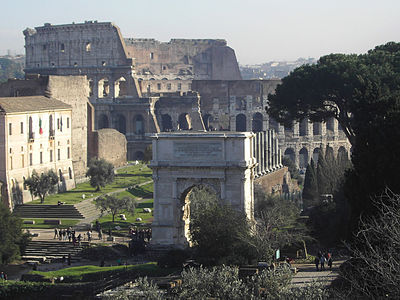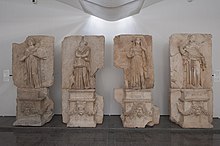Josephus
Flavius Josephus (born 37/38 AD in Jerusalem; died c. 100 probably in Rome) was a Jewish Hellenistic historian.
As a young priest from the Jerusalem upper class, Josephus had an active role in the Jewish War: He defended Galilee in the spring of 67 against the Roman army under Vespasian. At Jotapata he fell into Roman captivity. He prophesied to the commander Vespasian his future emperorship. As a freedman, he accompanied Vespasian's son Titus in the final phase of the war and thus witnessed the conquest of Jerusalem (70 AD). With Titus the following year he came to Rome, where he spent the rest of his life. He received Roman citizenship and henceforth lived on an imperial pension and the proceeds of his estates in Judea. He used his leisure to write several works in Greek:
- A History of the Jewish War (cited in this article as: Bellum),
- A History of the Jewish People from the Creation of the World to the Eve of this War (cited as: Antiquitates),
- a short autobiography as an appendix to it (cited as: Vita)
- and, as a late work, a defense of Judaism against the criticism of contemporary writers (cited as: Contra Apionem).
Roman historians mentioned Josephus only as a Jewish prisoner with an oracle saying about Vespasian's emperorship. For all information on his biography, one must therefore rely on the Bellum and the Vita.
Josephus' writings have been preserved because they were discovered by Christian authors in late antiquity as a kind of reference work. In Josephus the reader of the New Testament found useful background information: He was the only contemporary author who spoke in detail and with his own local knowledge about Galilee. The city of Jerusalem and the temple there are also described in detail. Josephus mentioned John the Baptist and probably also Jesus of Nazareth - however, this passage (the so-called Testimonium Flavianum) has been revised by Christians and the original wording is uncertain. In the Bellum Josephus described in detail the suffering of the people in besieged Jerusalem. He broke with the conventions of ancient historiography that required him to be factual in lamenting the misfortunes of his homeland. Since Origen, Christian theologians have interpreted these accounts of the war as God's judgment on the Jews, a consequence of Jesus' crucifixion, which in their eyes was the fault of the Jews.
For the history of Judea from about 200 BC to 75 AD, Josephus' works are the most important ancient source. His unique selling point is that, as an ancient Jew, he provides information about his childhood and youth on the one hand and his role in the war against Rome on the other. However, the reader never encounters the young Galilean military leader directly, but contradictory images that an older Roman citizen drew of his former self.
Recent scholarship is concerned with how Josephus made his way as a Jewish historian in Flavian Rome. The inhabitants of Rome were constantly confronted with the issue of Judea, as Vespasian and Titus celebrated their victory in a rebellious province with triumphal processions, coinage, and monumental architecture as if it were a new conquest. Josephus set himself the task of telling the story of this war differently to the victors, as one of the defeated. The result is a hybrid work that combines Jewish, Greek, and Roman. This makes Josephus an interesting author for postcolonial reading.

The Rome of the Flavians as a memorial landscape of the victory over Judea: in the foreground the Arch of Titus, in the background the Amphitheatrum Flavium, financed from the spoils of war.
Individual topics of Josephus research
Text research
The only surviving papyrus fragment with Josephus' text, Papyrus Vindobonensis Graecus 29810 (late 3rd century AD), is a good illustration of the considerable difference between the medieval manuscripts and the original text of Josephus: the fragment in the Austrian National Library comes from an edition of the Bellum and contains 112 words in whole or in part; nine times this text deviates from all the manuscripts available to Benedikt Niese for his scholarly text edition. Of the four works of Josephus, the Bellum is comparatively the best preserved.
Niese produced the most authoritative edition of the Greek text of Josephus to date, an edition with an extensive text-critical apparatus (Editio maior, 7 vols., 1885-1895) and an edition with a more concise apparatus (Editio minor, 6 vols., 1888-1895), which is regarded as his last-hand edition. Since then, some 50 manuscripts have become known which Niese has not yet been able to use. Translations or bilingual editions have been produced in several European countries, making changes to Niese's text. If this trend continues, it will become unclear which Greek text experts refer to in their publications. Heinz Schreckenberg therefore believes that a new major critical text edition is urgently needed, or at least a revision of Niese's work. Until then, according to Tommaso Leoni, Niese's Editio maior nevertheless offers the relatively best text of the Bellum, but this is sometimes hidden in the critical apparatus.
The textual corruptions in the Antiquitates are partly a consequence of medieval copyists approximating Josephus' Bible retelling to the Greek biblical text of the Septuagint. Since 1992, a French team led by Étienne Nodet has been working on a new manuscript stemma for books 1 to 10 of the Antiquitates, with the result that two 11th-century manuscripts, which Niese considered less important, seem to offer the best text:
- Codex Vindobonensis historicus Graecus 20 (in Niese: "historicus Graecus No. 2"), Austrian National Library;
- Codex Parisinus Graecus 1419, French National Library.
The Münster edition of the Vita offers a mixed text that differs from Niese's Editio maior in that it incorporates the Codex Bononiensis Graecus 3548, which is in the University Library of Bologna. Although relatively late (14th/15th century), it is classified as a witness to the best tradition.
Contra Apionem is the worst preserved work of Josephus. All Greek witnesses, even the indirect ones, depend on a codex in which several leaves were missing; this large gap in the text must be filled in with the help of the Latin translation. Niese assumed that all recent Greek manuscripts were 11th-century copies of Codex Laurentianus 69,22. The Münster team of translators (Folker Siegert, Heinz Schreckenberg, Manuel Vogel), on the other hand, evaluates the Codex Schleusingensis graecus 1 (15th/16th century, library of the Hennebergsche Gymnasium, Schleusingen) as evidence of a partially independent tradition. Arnoldus Arlenius had used this codex for the first edition of the Greek text of Josephus printed in 1544. The readings of this printed edition that deviate from Laurentianus thus receive greater weight; until then, they had been considered conjectures by Arlenius.
Archaeology in Israel/Palestine
→ Main article: Gamla, Jotapata and Masada
Since the middle of the 19th century, Palestine researchers have been searching for ancient sites or buildings "with Josephus in one hand and a spade in the other" - a success story that continues to the present day, says Jürgen Zangenberg. But it is methodologically questionable, he said. "Any interpretation, especially of the supposedly merely 'factual' passages, must ... begin with the fact that Josephus is first and foremost an ancient historian."
Just as Yigael Yadin harmonized the excavation findings from Masada with the account of Josephus, the excavator of Gamla, Shmarya Guttman, also found the account of the Roman conquest of this fortress in the Golan confirmed in many details. According to Benjamin Mazar, the findings of Israeli excavations along the southern and western perimeter walls of the Temple Mount since 1968 illustrate construction details of the Herodian Temple described in the Bellum and Antiquitates. More recent examples of archaeological features being interpreted with the help of Josephus include the excavations at Jotapata (Mordechai Aviam, 1992-1994) and the identification of a palace and hippodrome at Tiberias (Yizhar Hirschfeld, Katharina Galor 2005).
The "credibility" of Josephus has been discussed several times in research. On the one hand, the archaeological evidence often confirms Josephus' statements or at least can be interpreted in this way. On the other hand, there are examples where Josephus makes blatantly false statements, for example about distances, measurements of buildings or population sizes. This is partly explained by copyist errors. A well-known and difficult problem of research are Josephus' descriptions of the Third Wall, i.e. the outer northern city fortifications of Jerusalem. Michael Avi-Yonah characterized them as a jumble of impossible distances, disparate descriptions of the same events, and a chaotic use of Greek technical vocabulary. Kenneth Atkinson elaborated on contradictions between the excavation results at Gamla and Masada and the war account in the Bellum. He argues that one must assume that the Roman capture took place in a historically different way than Josephus depicts. For example, due to the conditions on the mountain top, it is not at all possible that 9000 defenders, when the Roman army entered Gamla, threw themselves from there into the depths and thus committed collective suicide. Gamla was also only weakly fortified and offered little resistance to Vespasian's army. Shaye Cohen had already previously questioned the combination of archaeological evidence and Josephus' account of the end of Masada.
Postcolonial reading
Homi K. Bhabha has advanced postcolonialism by arguing that colonists and colonized interact in complex ways. The rulers expect the inferiors to imitate their culture. The latter do so too - but not properly, not completely. A basic contradiction of colonialism is that it wants to educate and civilize the colonized, but claims a permanent difference to them: In other words, natives can become Anglicized but never English.
The colonized, however, can creatively use the dominant culture for self-assertion (resistant adaptation). This approach makes it possible to read Josephus' work beyond the alternatives of Flavian propaganda and Jewish apologetics: Josephus and other historians with roots in the east of the empire sought to "tell their own story in an idiom that the majority culture(s) understood, but with primary reference to their own traditions-and for their own purposes."
An example from the Bellum: Herod Agrippa II tries to dissuade the Jerusalemites from war against Rome by stating, in the style of imperial propaganda, that Rome rules the whole world. His speech has the known peoples of antiquity with their respective special abilities paraded by; Rome has defeated them all (mimicry of a gentes-devictae list). Agrippa (or Josephus), however, attributes this not to the favor of Jupiter, but to the god of the defeated Jews. Thus, according to David A. Kaden, he destabilizes the dominant imperial discourse. One no longer really knows whether it is a Jew or a Roman speaking. Bhabha characterizes the situation of cultural border crossers with the term in-between-ness, roughly "sitting between the chairs". When Josephus describes how he himself, on behalf of the Romans, gave a speech to the defenders in their mother tongue in front of the wall of besieged Jerusalem, he embodies in-between-ness in his own person.

The Sebasteion of Aphrodisias is considered a classical representation of the gentes-devictae propaganda of Rome. Here the personifications of four defeated peoples; only in the case of the ethnos of the Piroustae on the far left is the affiliation of the inscription base and the sculpture clear (Archaeological Museum of Aphrodisias).

Replica of a Roman ballista, in the background the archaeological site Gamla
Search within the encyclopedia